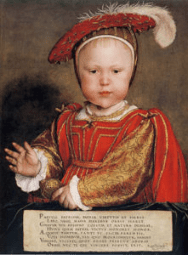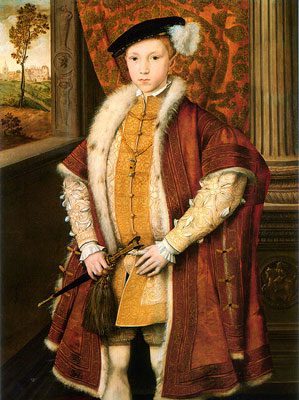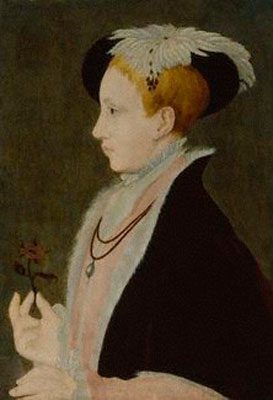Son of Henry VIII and of his third wife Jane Seymour, Edward became king of England at the age of nine and reigned for only a little over six years. Because of the importance of having a male heir, his father took every precaution to preserve him from any contagion and especially from contact with anyone ill. There were detailed instructions to have the floors scrubbed twice daily, dirty dishes removed promptly, and food prepared carefully. In that respect, Edward served as model for Mark Twain’s story of The Prince and the Pauper. Except for an episode of fever at age four, Edward remained in good health until April 1552, when he had an acute illness with a rash, measles or smallpox or perhaps both coexisting. By the middle of 1552 he had fully recovered.
In January 1553 Edward became ill with fever, progressive weakness, and shortness of breath. He was troubled by a persistent cough productive of greenish-yellow and black blood-stained sputum. His legs swelled so severely that he had to lie on his back. He became increasingly worse and died in July 1553. At autopsy two large “putrefied ulcers” were found in his lungs. His physicians declared that he had died of consumption, which has been interpreted as tuberculosis, a diagnosis supported by the fact that he would have been in contact with several family members probably so afflicted, including his grandfather Henry VII, his paternal uncle Prince Arthur, and also his half-brother, the Duke of Richmond. It has also been suggested that his previous illness, which may have been measles, had suppressed his natural immunity to disease, a fact well described in the medical literature. Other historians, however, have suggested that the initial illness was pneumonia and that from this he developed a lung abscess leading to septicemia and kidney failure.

of England, ca. 1538
Hans Holbein
Oil and tempera on oak
22.4” x 17.3”
The National Gallery of Art

Attributed to William Scrots
Oil on panel
42.2″ x 32.3″
The Royal Collection

Studio of William Scrots
Oil on panel
18 5/8” x 11”
National Portrait Gallery
The painting of Prince Edward at age one (1538) is in the National Gallery in Washington and is the work of German-born Holbein the Younger (1497–1543). Holbein went to England for the first time at the age of twenty-nine and quickly established an international reputation as a painter of portraits. He became the exclusive court portrait painter to King Henry VIII, painting among others the portraits of potential brides for the king. He held his position until his death in 1543.
The portrait of Edward at his coronation (ca. 1546) has been derived from the one in the National Portrait Gallery, London, and has been attributed to Netherlandish mannerist artist William Scrots, who in 1546 followed Hans Holbein as royal painter to Henry VIII, with a salary over twice as much as Holbein’s thirty pounds a year. Scrots continued in this position during the reign of Edward VI, after whose death his salary was stopped and it is presumed that he left England, but nothing else is known about his later life.
Reference
- Holmes, G., F. Holmes, and J. McMorrough. 2001. “The Death of Young King Edward VI.” New Engl J Med 345:60–62.

Leave a Reply